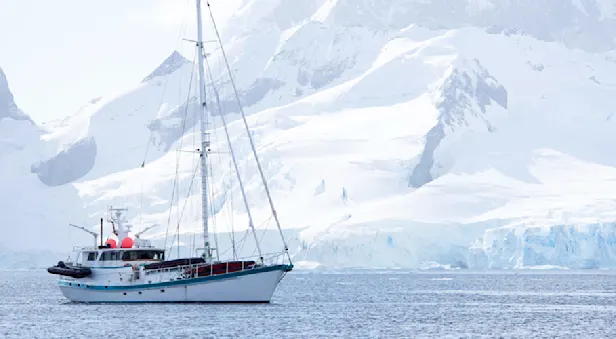Albatross Facts | Antarctica Wildlife Guide
Albatrosses are large seabirds with extremely long wingspans and short tails. They travel vast distances by utilizing a gliding flight, stopping periodically to rest on the ocean’s surface. In tempestuous weather, the albatross rides the wind, swooping toward the waves and rising back up without even flapping its wings.
Albatrosses are usually encountered in the open ocean, and they frequently trail vessels, riding the currents of air produced by the ship’s movement in hopes of finding discarded food. Albatrosses eat small fish, krill and squid, dipping their heads into the water to snatch up prey.
These seabirds are built for life on the water, possessing webbed feet and stocky, sturdy legs for swimming. To achieve flight, they typically run along the water’s surface with the wind at their back before taking off. There are more than one dozen species of albatross of various sizes. Large species include the royal albatross and the wandering albatross: the latter of which has the longest wings of any living bird, with a total wingspan of up to 11.5 feet (3.45 meters). The small albatrosses are often called “mollymawks”—a Dutch word meaning “foolish gull”—and have wingspans of about 7 to 7.5 feet.
These big, graceful birds are noted for their long-distance flights. The champion in this respect is the biggest of all, the wandering albatross, which journeys from sub-tropical to Antarctic waters. Using satellite telemetry, scientists have discovered that parent birds fly as much as 560 nautical miles per day at airspeeds of 50 nautical miles per hour. They cover anywhere from 1,800 miles to an amazing 9,300 miles in a single foraging flight! Young adult wandering albatrosses spend several years at sea before returning to land to breed at about 7 years of age.
Most albatrosses perform intricate courting dances, and mating follows from late spring to early summer. They construct mounds of mud, moss, feces and grass, which form their nests and rest in island areas that provide suitable flight paths to the sea. Females lay a single egg.
Smaller albatrosses incubate their eggs between 60 and 70 days, and incubation for larger species lasts 80 days. Both parents share incubation and feeding duties, regurgitating their food until the chick fledges. While smaller species mate each year, large albatrosses breed only every two years.
Albatrosses, along with petrels, prions, shearwaters, storm-petrels, fulmars, and diving petrels, are members of a group of seabirds called procellariiformes. But they have another name which is easier to remember: tubenoses. This refers to their external tubular nostrils that are mounted on grooved, hooked bills. They expel excess salt from their systems through these nostrils, and a saline solution can often be seen dripping from them (or forcibly ejected). They have a well-developed sense of smell.
See Albatrosses on These Antarctic Expeditions

Sailing Antarctica: A Polar Wildlife Expedition
Those with a passion for true adventure won't find a more exhilarating thrill than exploring Antarctica on an intimate voyage by private motorsailer—for just seven guests! Kayak and camp on the ice, too.

































